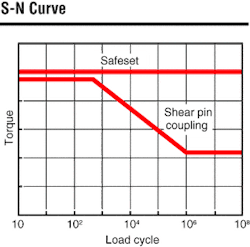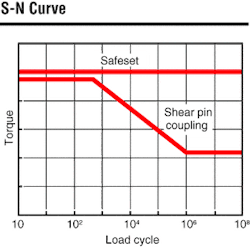Safety coupling ensures overload protection
The Safeset safety coupling has been developed by Voith Safeset of Hudiksvall, Sweden, to provide a high level of security against the expensive damage that can be caused through overloads to rotating machinery. The device has been on the market since 1980 and is widely used in the steel and rail industries. It recently entered service offshore, where it is protecting LM 2500 and LM 6000 gas turbines from General Electric. Gas turbines based on aircraft technology are vulnerable to damage when used for power generation if a short circuit causes a high torque peak in the generator.
Unlike shear pins, which are weakened by fatigue, the Safeset torque limiter can be adjusted to meet any chosen torque setting and to retain that setting indefinitely. This is possible over many loading cycles that would significantly weaken a shear pin. The performance is achieved through use of a hollow, thin-walled pressure sleeve that acts as the interface between the two shaft components.
Oil inside the sleeve is pressurized so that it expands to provide the friction needed to hold the coupling together. Oil pressure up to 1,000 bar can be chosen to determine the torque at which the sleeve will cease to provide sufficient friction. When this happens, a shear ring fixed to the shaft will turn and cut off the end of a shear tube. This allows the oil in the sleeve to escape instantly so that the friction is eliminated and the overloaded part of the shaft is freed to turn independently of the turbine in a process that takes only milliseconds. When the overload problem has been eliminated, a replacement shear tube is fitted, the sleeve is re-filled with oil and pressurized.
Each Safeset coupling is provided with a calibration diagram that shows the ratio between the oil pressure and the torque required and enables the user to introduce variations in release torque as required. With the coupling restored, it is immediately ready to continue its function of protecting the machinery.
No shear pin fatigue
The nature of the Safeset design makes it more compact, and its weight can, in certain cases, be as low as 1/20 the weight of comparable couplings that uses shear pins. The other major advantage is the system's reliability compared with shear pins, which are vulnerable to breakage caused by the fatigue suffered over numerous load cycles. To compensate for this weakness, it is normal to specify a shear pin with a torque yield that is five times greater than the normal load so that it can provide reliable service over a long period.
According to Safeset, 75% of pin breakages are caused not by overload but simply because the pin has failed due to fatigue. Because the design does not use a pin to help transmit the torque, a Safeset coupling will usually have its release value set at just twice the damage level to provide the user with a higher level of protection.
In addition to turbine generators, offshore applications for Safeset couplings can be found in mud pumps and water injection pumps, where they can protect electric motors.
High friction ceramic
Another recent development in the Voith Turbo range of couplings is the Hycon. This employs a ceramic coating for the unit's friction surfaces. Because the Hycon coating more than doubles the friction factor, it is possible to manufacture compact couplings with a corresponding increase in the transmittable torque, but without increasing the length and overall area of the friction surfaces. The design has been subjected to careful evaluation and subsequent type approval by Det Norske Veritas, and a Hycon coupling has been used to connect shafts subjected to up to 7,000 kNm of torque.
The Hycon connection consists mainly of a tapered sleeve and a tapered hub. By means of a sealed piston sleeve, a piston space is created that exerts hydraulic axial forces on the hub when pressure is applied. Consequently, the hub is pushed up the taper of the sleeve, which results in a radial compression. To carry out this process at minimum pressure and without wear, the surface of the taper is lubricated with pressurized oil. The surface of the taper is sealed on both sides so that no leakage occurs. To release the connection, oil is pumped in between the tapered surfaces until they are separated and the sleeve is moved by the axial forces generated.
For more information, contact Lars Häggroth, Voith Safeset. Tel: +46 650 54 01 63, fax: +46 650 54 01 65, email: [email protected], website: www.safeset.com.
A hollow steel sleeve is expanded by oil under pressure, producing a friction connection between a shaft and a hub. At overload, the coupling instantaneously releases the oil pressure and interrupts the drive.


